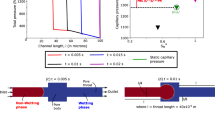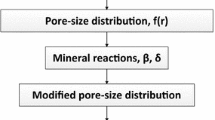Abstract
This article describes a semi-analytical model for two-phase immiscible flow in porous media. The model incorporates the effect of capillary pressure gradient on fluid displacement. It also includes a correction to the capillarity-free Buckley–Leverett saturation profile for the stabilized-zone around the displacement front and the end-effects near the core outlet. The model is valid for both drainage and imbibition oil–water displacements in porous media with different wettability conditions. A stepwise procedure is presented to derive relative permeabilities from coreflood displacements using the proposed semi-analytical model. The procedure can be utilized for both before and after breakthrough data and hence is capable to generate a continuous relative permeability curve unlike other analytical/semi-analytical approaches. The model predictions are compared with numerical simulations and laboratory experiments. The comparison shows that the model predictions for drainage process agree well with the numerical simulations for different capillary numbers, whereas there is mismatch between the relative permeability derived using the Johnson–Bossler–Naumann (JBN) method and the simulations. The coreflood experiments carried out on a Berea sandstone core suggest that the proposed model works better than the JBN method for a drainage process in strongly wet rocks. Both methods give similar results for imbibition processes.
Similar content being viewed by others
Abbreviations
- D :
-
Velocity of the shock front
- f :
-
Fractional flow of water phase
- \({{f}_{\rm s}^{{\prime}}}\) :
-
Derivative of fractional flow w.r.t. saturation
- F w_wet :
-
Fraction of the water-wet rock surface
- J :
-
Leverett function
- k :
-
Permeability
- k ro :
-
Oil relative permeability
- k ro_max :
-
Maximum oil relative permeability
- k rw :
-
Water relative permeability
- k rw_max :
-
Maximum water relative permeability
- L :
-
Core length
- n :
-
Exponent for Corey-type power law
- p :
-
Pressure
- P c :
-
Capillary pressure
- s :
-
Water phase saturation
- s i :
-
Initial water saturation
- s ir :
-
Irreducible water saturation
- s 0 :
-
Maximum water saturation, equals to unity minus residual/critical oil saturation
- t :
-
Time
- T :
-
Dimensionless time, p.v. injection
- T p :
-
Pore volumes produced
- T op :
-
Pore volumes of oil produced
- T wp :
-
Pore volumes of water produced
- U :
-
Velocity
- x :
-
Linear coordinate, from injectors towards producers
- X :
-
Dimensionless linear coordinate
- λ :
-
Total mobility of the oil-water fluid
- Ψ :
-
Potential for capillary forces
- \({\varepsilon}\) :
-
Capillary-viscous ratios
- \({\xi}\) :
-
Self-sharpening large scale (slow) coordinate
- \({\omega}\) :
-
Travelling wave fast coordinate near to the displacement front
- \({\zeta}\) :
-
Fast coordinate near to the core outlet
- \({\phi}\) :
-
Porosity
- μ :
-
Fluid viscosity
- σ :
-
Interfacial tension
- θ :
-
Contact angle
- W, O:
-
Water, oil
- i:
-
Initial (of water saturation)
- 0:
-
Boundary value on the injector (saturations, flux)
- BL:
-
Buckley–Leverett
- BT:
-
Breakthrough
- SZ:
-
Stabilized zone
- ee:
-
End effect
- min:
-
Minimum
References
Alizadeh, A.H., Keshavarz, A., Haghighi, M.: Flow rate effect on two-phase relative permeability in Iranian carbonate rocks. In: SPE middle east oil and gas show and conference, Bahrain, 11–14 Mar 2007
Amyx J., Bass D., Whiting R.: Petroleum reservoir engineering: physical properties. McGraw-Hill College, New York (1960)
Anderson W.: Wettability literature survey part 5: the effects of wettability on relative permeability. J. Petroleum Technol. 39, 1453–1468 (1987)
Bacri J.C., Leygnac C., Salin D.: Evidence of capillary hyperdiffusion in two-phase fluid flows. J. Phys. Lett. 46, 467–473 (1985)
Barenblatt G., Entov V., Ryzhik V.: Theory of fluid flows through natural rocks. Kluwer Academic Publishers, Dordrecht (1991)
Basbug, B., Karpyn, Z.: Determination of relative permeability and capillary pressure curves using an automated history-matching approach. In: SPE eastern regional/AAPG eastern section joint meeting, Pittsburgh, 11–15 Oct 2008
Batycky J., Mccaffery F., Hodgins P., Fisher D.: Interpreting relative permeability and wettability from unsteady-state displacement measurements. Old SPE J. 21, 296–308 (1981)
Bedrikovetsky P.: Mathematical theory of oil and gas recovery: with applications to ex-USSR oil and gas fields. Kluwer Academic Publishers, Boston (1993)
Bedrikovetsky, P., Rodrigues, J., Britto, P.: Analytical model for the waterflood honouring capillary pressure (with applications to laboratory studies). In: SPE Latin America/Caribbean petroleum engineering conference, Port-of-Spain, 23–26 Apr 1996
Buckley S., Leverett M.: Mechanism of fluid displacement in sands. Trans. AIME. 146, 107–116 (1942)
Burdine N., Gournay L., Reichertz P.: Pore size distribution of petroleum reservoir rocks. Trans. AIME. 189, 195–204 (1950)
Chardaire-Riviere C., Chavent G., Jaffre J., Liu J., Bourbiaux B.: Simultaneous estimation of relative permeabilities and capillary pressure. SPE Form. Evaluation 7, 283–289 (1992)
Christiansen, R.: Two-phase flow through porous media. Colorado School of Mines, Golden (2001)
Civan F., Donaldson E.: Relative permeability from unsteady-state displacements with capillary pressure included. SPE Form. Evaluation 4, 189–193 (1989)
Donnez P.: Essentials of reservoir engineering. Technip Editions, Paris (2007)
Erdélyi A.: Asymptotic expansions. Dover Pubns, New York (1956)
Gel’fand I.: Some problems in the theory of quasi-linear equations. Uspekhi Matematicheskikh Nauk 14, 87–158 (1959)
Hamming R.: Numerical methods for scientists and engineers. Dover Publications, Mineola (1986)
Honarpour M., Koederitz L., Harvey A.: Relative permeability of petroleum reservoirs. CRC Press, Boca Raton (1986)
Huang D., Honarpour M.: Capillary end effects in coreflood calculations. J. Petroleum Sci. Eng. 19, 103–118 (1998)
Hussain, F., Cinar, Y., Bedrikovetsky, P.: Comparison of methods for drainage relative permeability estimation from displacement tests. In: SPE IOR Symposium, Tulsa (2010)
Islam, M., Bentsen, R.: A dynamic method for measuring relative permeability. JCPT, Jan–Feb, pp. 39–50 (1986)
Johnson E., Bossler D., Naumann V.: Calculation of relative permeability from displacement experiments. Trans. AIME. 216, 370–372 (1959)
Jones S., Roszelle W.: Graphical techniques for determining relative permeability from displacement experiments. J. Petroleum Technol. 30, 807–817 (1978)
Kalbus, J., Christiansen, R.: New data reduction developments for relative permeability determination. In: ATC & Exhibition, Dallas, 22–25 Oct 1995
Kerig P., Watson A.: Relative-permeability estimation from displacement experiments: an error analysis. SPE Reserv. Eng. 1, 175–182 (1986)
Kevorkian J., Cole J., John F.: Perturbation methods in applied mathematics. Springer-Verlag, New York (1981)
Krause M., Perrin J.C., Benson S.: Recent progress in predicting permeability distributions for history matching core flooding experiments. Energy Procedia 4, 4354–4361 (2011)
Nayfeh A.: Perturbation methods. Wiley, New York (1973)
Nordtvedt, J., Urkedal, H., Ebeltoft, E., Kolltveit, K., Petersen, E., Sylte, A., Valestrand, R.: The significance of violated assumptions on core analysis results. In: International symposium of the society of core analyts, Golden (1999)
Odeh A., Dotson B.: A method for reducing the rate effect on oil and water relative permeabilities calculated from dynamic displacement data. J. Petroleum Technol. 37, 2051–2058 (1985)
Perrin J.C., Benson S.: An experimental study on the influence of sub-core scale heterogeneities on CO2 distribution in reservoir rocks. Transp. Porous Med. 82, 93–109 (2010)
Poulsen, S., Skauge, T., Dyrhol, S., Stenby, E.H., Skauge, A.: Including capillary pressure in simulations of steady state relative permeability experiments. In: International symposium of the society of core analyts, Abu Dhabi (2000)
Purcell W.: Capillary pressures–their measurement using mercury and the calculation of permeability therefrom. Trans. Am. Inst. Min. Metall. Pet. Eng. 186, 39–48 (1949)
Qadeer S.: Techniques to handle limitations in dynamic relative permeability measurements. Stanford University, California (2001)
Qadeer, S., Brigham, W., Castanier, L.: Techniques to handle limitations in dynamic relative permeability measurements. National petroleum technology office, Tulsa, Prepared for US Department of Energy Assistant Secretary for Fossil Energy, p. 142 (2002)
Qadeer, S., Dehghani, K., Ogbe, D., Ostermann, R.: Correcting oil/water relative permeability data for capillary end effect in displacement experiments. In: SPE California regional meeting, Long Beach, 23–25 Mar (1988)
Ramakrishnan T., Cappiello A.: A new technique to measure static and dynamic properties of a partially saturated porous medium. Chem. Eng. Sci. 46, 1157–1163 (1991)
Rapoport L., Leas W.: Properties of linear waterfloods. Trans. AIME. 198, 139–148 (1953)
Richmond P., Watsons A., Texas A.: Estimation of multiphase flow functions from displacement experiments. SPE Reserv. Eng. 5, 121–127 (1990)
Sigmund P., Mccaffery F.: An improved unsteady-state procedure for determining the relative-permeability characteristics of heterogeneous porous media. Soc. Petroleum Eng. J. 19, 15–28 (1979)
Subbey S., Monfared H., Christie M., Sambridge M.: Quantifying uncertainty in flow functions derived from SCAL data. Trans. Porous Med. 65, 265–286 (2006)
Tikhonov A., Arsenin V., John F.: Solutions of ill-posed problems. Vh Winston, Washington (1977)
Toth J., Bodi T., Szucs P., Civan F.: Convenient formulae for determination of relative permeability from unsteady-state fluid displacements in core plugs. J. Petroleum Sci. Eng. 36, 33–44 (2002)
Tsakiroglou, C., Avraam, D., Payatakes, A.: Simulation of the immiscible displacement in porous media using capillary pressure and relative permeability curves from transient and steady-state experiments. In: International symposium of the society of core analysts, Abu Dhabi, UAE (2004)
Udegbunam E.: A FORTRAN program for interpretation of relative permeability from unsteady-state displacements with capillary pressure included. Comput. Geosci. 17, 1351–1357 (1991)
Van Dyke M.: Perturbation methods in fluid mechanics/Annotated edition. NASA STI/Recon Tech. Report A. 75, 46926 (1975)
Virnovsky, G., Skjaeveland, S., Surdal, J., Ingsoy, P.: Steady-state relative permeability measurements corrected for capillary effects. In: SPE annual technical conference and exhibition, Dallas, 22–25 Oct 1995
Welge H.: A simplified method for computing oil recovery by gas or water drive. Trans. Am. Inst. Min. Metall. Petrol. Eng. 195, 91–98 (1952)
Author information
Authors and Affiliations
Corresponding author
Rights and permissions
About this article
Cite this article
Hussain, F., Cinar, Y. & Bedrikovetsky, P. A Semi-Analytical Model for Two Phase Immiscible Flow in Porous Media Honouring Capillary Pressure. Transp Porous Med 92, 187–212 (2012). https://doi.org/10.1007/s11242-011-9897-4
Received:
Accepted:
Published:
Issue Date:
DOI: https://doi.org/10.1007/s11242-011-9897-4




